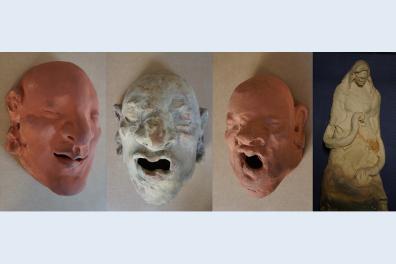Inalco welcomes a collection of works by Japanese sculptor KINJŌ Minoru
Menu INALCO

During an exhibition in Paris in 1992, KINJŌ Minoru donated some of his works to Kolin Kobayashi, a Paris-based Japanese journalist involved in the anti-nuclear struggle.
M. Kolin Kobayashi, through Makiko Andro, lecturer in Japanese language and literature at Inalco, has entrusted these works to the Institute for conservation and enhancement.
The bequest consists of 6 statuettes, nobotoke (lit. Buddha of the fields) and a series of 20 masks, men, in terracotta. These pieces, which express the joy and sorrow of an entire people, illustrate a page in Japan's modern history.
Inventoried by the Service de l'Information scientifique, des Archives et du Patrimoine (SISAP) under the reference 2FI Don Kolin Kobayashi - Œuvres de KINJŌ Minoru, these sculptures are now the subject of a permanent exhibition in the spaces of the Maison de la recherche, at 2 rue de Lille.
The exhibition of this collection was conceived by two Inalco experts in Japanese art: Estelle Bauer, art historian of classical Japan, and Michael Lucken, historian and art historian, in close collaboration with the Institute's Service de l'Information scientifique, des Archives et du Patrimoine (SISAP) and Service événementiel et action culturelle (SEAC).
The masks were custom-bracketed and hung by specialist company Version Bronze.
It featured a vernissage at the end of September, during which the text Mon combat. The meaning of art, taken from the book Le rire de la terre by KINJŌ Minoru.
The artist and the sculptures
The three cartel entries below were written by Michael Lucken.
KINJŌ Minoru
KINJŌ Minoru 金城 実 was born in 1939 on Hamahiga-jima, a small island east of Okinawa in southern Japan. Raised by his mother, a war widow, and his maternal grandfather, a fisherman, he grew up in a remote rural environment. In 1954, in the midst of the American occupation, he entered Maehara High School on Okinawa's main island. In 1957, he left for Tokyo, then Kyoto, where in 1960 he enrolled at the University of Foreign Languages to study English.
Parallel to this, KINJŌ became interested in sculpture, which he learned largely on his own.
Earning a living as an English teacher, from 1970, shortly before Okinawa's retrocession to Japan (1972), he developed a body of work entirely devoted to commemorating the suffering endured by minorities in Japanese society. After an initial period marked by the creation of monumental compositions, such as L'appel de la libération (1977), in the 1980s he attempted to incorporate these painful memories into forms derived from folklore.
Becoming a charismatic figure in the movement for the dismantling of American bases and the autonomy of Okinawa, in 1992 KINJŌ exhibited a set of terracotta masks and statuettes in Paris, a large part of which he donated to the Inalco in 2020. Author of several books, including Le rire de la terre (1983) and La question du Yasukuni vue d'Okinawa (2006), he is involved in many memorial conflicts, such as the issue of Korean comfort women, which he takes as the subject of a work in 2019.
The statuettes, Nobotoke (Field Buddha)
KINJŌ Minoru, Nobotoke, terracotta, ht. 40~47 cm, 1992
These six statuettes are part of a series of some sixty works created by the artist in collaboration with teenagers punished by Japanese justice for defacing an Okinawa monument commemorating the controversial gesture of dozens of civilians who took their own lives in 1945 as American troops approached.
The term nobotoke (lit. field Buddha) generically refers to all the small statuettes of popular Buddhism set up along roadsides and on the outskirts of towns. But it can also have a more specifically funerary dimension and apply to deities who console and accompany the dead, particularly in the context of the Pure Land schools.
These nobotoke convey this dual heritage: in taking up this traditional theme, the sculptor is part of a movement to revitalize folk art that runs through the entire 20th century, but he also manifests a desire to move away from the anger and dark heroism that had hitherto characterized his art, to express more compassion for the victims of Okinawa's tormented history.
The masks
KINJŌ Minoru, Masks, terracotta, ht. 20~24 cm, c1992
These tormented faces evoke oni, beings who perished of death and struggle against oblivion, like the civilians who, in 1945 in Okinawa, took their own lives at the approach of the Americans.
Made with earths of very different density, texture and color, these masks present themselves as a metaphor for human diversity. But the freedom of their workmanship also testifies to the plastic and transitory nature of human emotions and affairs, constantly oscillating between laughter and tears, farce and tragedy.
These masks (jap. men), which form a counterpart to the statuettes in the reception, testify to a turning point in the artist's work. Moving away from the models that had influenced him in his youth (Auguste Rodin, Käthe Kollwitz), the sculptor found in the universal theme of the mask a means of going beyond the expression of particular dramas, to give his works a more general scope.
Mon combat. Le sens de l'art par Kinjô Minoru (traduit du japonais par M. Lucken) (201.72 KB, .pdf)